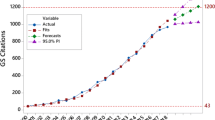Abstract
Recent studies propose the use of discrete event simulation models as a tool to help teaching. That is suggested mainly due to the current development of software and its visual animation resources. Therefore, this paper presents simulation models to assist teaching in high school classes. The models were used to analyse the concepts of switching time and also reflection and refraction of light. Three types of comparisons were performed to evaluate the models. First, with other existing simulators; second, according to the grades of students who used the simulator developed; and third, with students who have not used this teaching resource. The results looked promising and showed that there is potential for the use of simulation as additional resources in classes.








Similar content being viewed by others
References
Adams J, Flatto J and Gardner L (2005). Combining hands-on, spreadsheet and discrete event simulation to teach supply chain management, Winter Simulation Conference, Orlando, FL, pp 2329–2337.
Banks J, Carson JS, Nelson BL and Nicol DN (2009). Discrete-Event System Simulation, 5th edn. Prentice-Hall: New Jersey, p 640.
Christou IT, Efremidis S, Tiropanis T and Kalis A (2007). Grid-based virtual laboratory experiments for a graduate course on sensor networks. IEEE Transactions on Education 50 (1): 17–26.
Garrido J., M. et and Bandyopadhyay T (2009). Simulation model development in information security education, Information Security Curriculum Development Conference Kennesaw, GA, New York.
Goldsman D, Nance RE and Wilson JR (2010). A brief history of simulation revisited. In: Johansson B, Jain S, Montoya-Torres J, Hugan J and Yücesan E (eds). Proceedings of the 2010 Winter Simulation Conference, Baltimore, MD, pp 567–574.
Hoffler TN and Leutner D (2007). Instructional animation versus static pictures: A meta-analysis. Learning and Instruction 17 (6): 722–738.
Kelton DW, Sadowski RP and Sturrock DT (2007). Simulation with Arena, 4th edn. Mc Graw Hill: New York, NY.
Kincaid JP and Westerlund KK (2009). Simulation in Education and Training. In: Rossetti MD, Hill RR, Johansson B, Dunkin A, Ingalls RG (eds). Proceedings of the 2009 Winter Simulation Conference, Austin, TX, pp 273–280.
Law AM (2007). Simulation Modeling & Analysis, 4th edn. McGraw-Hill: New York.
Martinez MA and Canãdas M (2010). A tool for the educational study of manufacturing systems. Computer Applications in Engineering Education. 18 (1): 130–143.
Nugroho IB and Suhartanto H (2010). Design and simulation of Indonesian education grid topology using gridsim toolkit. Asian Journal of Information Technology 2010 9 (5): 263–271.
Pidd M (2004). Computer Simulation in Management Science, 5th edn. John Wiley & Sons: Chichester.
Robinson S (2004). Simulation: The Practice of Model Development and use. John Wiley & Sons.
Sargent RG (2013). Verifications and validation of simulations models. Journal of Simulation 7 (1): 12–24.
Silva TMP and Rangel JJA (2011). Discrete event simulation as didactic support to the teaching of telecommunications systems: applications in digital telephony. Winter Simulation Conference, Phoenix, AZ, pp 3893–3903.
Smeds R (2003). Simulation for accelerated learning and development in industrial management. Production Planning & Control 14 (2): 107–110.
Van der zee DJ and Slomp J (2005). Simulation and gaming as a support tool for lean manufacturing systems––a case example from industry. Winter Simulation Conference, Orlando, FL, pp 2304–2313.
White JR KP and Ingalls RG (2009). Introduction to simulation. Winter Simulation Conference, Austin, TX, pp 12–23.
Acknowledgements
The authors thank the National Council for Scientific and Technological Development (CNPq) and the Research Foundation of the State of Rio de Janeiro (FAPERJ) for financial support for this research. They also thank Maria Marta Garcia for her assistance in translating the text into English.
Author information
Authors and Affiliations
Rights and permissions
About this article
Cite this article
da Silva, T., de Assis Rangel, J., Shimoda, E. et al. Discrete event simulation to build simulators for teaching. J Simulation 8, 325–334 (2014). https://doi.org/10.1057/jos.2014.12
Received:
Accepted:
Published:
Issue Date:
DOI: https://doi.org/10.1057/jos.2014.12




